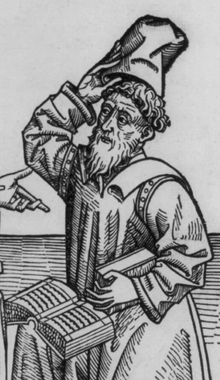Borzuya
Borzuya (or Burzōē or Burzōy) was a Persian physician[2] in the late Sassanid era, at the time of Khosrau I. He translated the Indian Panchatantra from Sanskrit into Pahlavi (Middle Persian). But both his translation and the original Sanskrit version he worked from are lost. Before their loss, however, his Pahlavi version was translated into Arabic by Ibn al-Muqaffa under the title of Kalila and Dimna or The Fables of Bidpai and became the greatest prose of Classical Arabic. The book contains fables in which animals interact in complex ways to convey teachings to princes in policy.
Borzuya | |
|---|---|
 Artwork of Borzūya | |
| Born | 5th century - 6th century |
| Died | 6th century Sassanid Iran |
| Education | Academy of Gondishapur (possibly) |
| Known for | Translating many books into Pahlavi |
| Medical career | |
| Profession | Physician |
The introduction to The Fables of Bidpai or Kalila and Dimna presents an autobiography by Borzūya. Beside his ideas, cognitions and inner development leading to a practice of medicine based on philanthropic motivations, Borzuya's search for truth, his skepticism towards established religious thought and his later asceticism are some features lucidly depicted in the text.[3] Borzuya originally came to India in 570 CE to find an elixir that would revive the dead. He later found out from a philosopher that the elixir was a metaphor for the Panchatantra.[4] He would later get permission to read the book from the King of India, however he could not copy it. Disobeying these instructions, Borzuya would read a chapter of the book a day and make a journal entry of what he read; effectively making a copy of the Panchatantra. He would later send this out to India to have it translated. [1]
There is considerable discussion whether Borzūya is the same as Bozorgmehr.[3] While sources indicate they are different people, the word "Borzūya" can sometimes be a shortened form of Bozorgmehr.[5]
See also
- Academy of Gundishapur
References
- "BORZŪYA – Encyclopaedia Iranica". www.iranicaonline.org. December 15, 1989.
- Zargaran, Arman; Mehdizadeh, Alireza; Yarmohammadi, Hassan; Kiani, Hossein; Mohagheghzadehl, Abdolali (2015). "BORZOUYEH, AN ANCIENT PERSIAN PHYSICIAN WHO FIRST REPORTED UTERINE CONTRACTIONS IN NORMAL VAGINAL DELIVERY". Acta medico-historica adriatica: AMHA. 13 Suppl 2: 23–28. ISSN 1334-4366. PMID 26959628.
- François de Blois (1990), Burzōy's voyage to India and the origin of the book of Kalīlah wa Dimnah, Routledge, ISBN 978-0-947593-06-3
- Roy, Nilanjana S. "The Panchatantra: The ancient 'viral memes' still with us". www.bbc.com. Retrieved 17 March 2019.
- Djalal Khaleghi-Motlagh, "BORZŪYA" in Encyclopaedia Iranica. Oneline link accessed in December 2010: BORZŪYA.